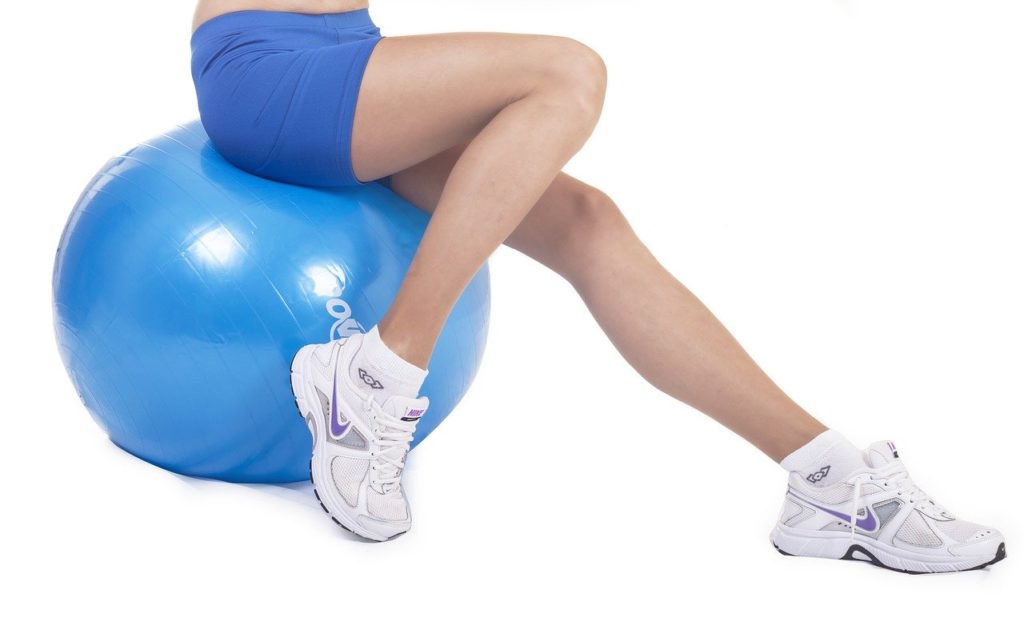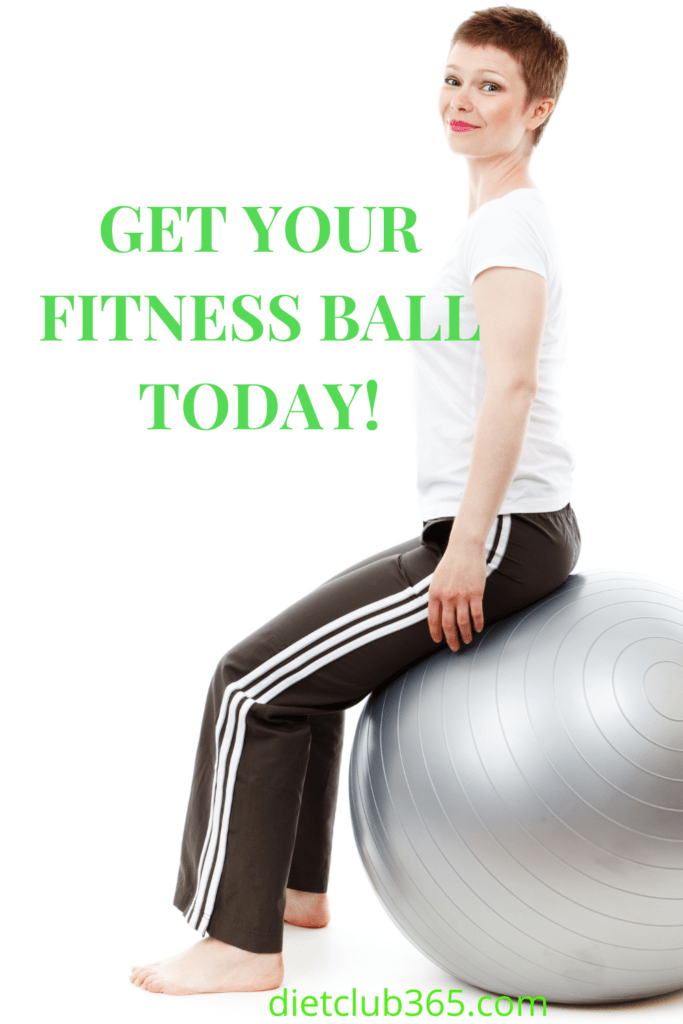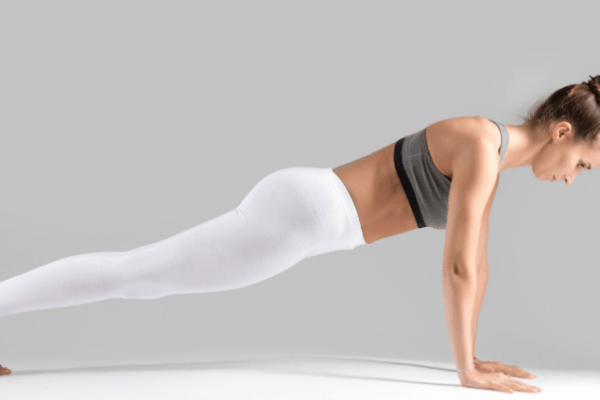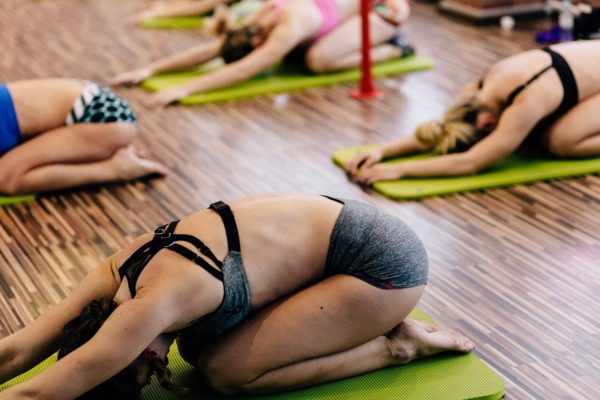Fitness ball is an effective tool for sculpting or even building up your abs and strengthening your core muscles. Since it is necessary to maintain balance when performing exercises on a fitness ball, this activates the deep stabilizing muscles, positively affecting posture.
The best exercises for the core on fitness ball are various turns and twists. When you are performing them, both the lateral abdominal muscles and the transverse abdominal muscles work. However, the emphasis when training with a fitness ball should not be on the number of repetitions, but on the observance of the correct exercise technique.
What is a fitness ball?

Since the lower back is fixed when performing exercises on the fitness ball, it was originally used for rehabilitation therapy. However, today, a gymnastic ball can be found in any gym. It is used both in functional training and in Pilates. The plus of the fitness ball is that it is great for ab workouts at home.
Abdominal exercises are one of the best ways to strengthen your core because attention must be paid to maintaining balance during movement. Ultimately, this develops a neuromuscular connection with the abs, helping to maintain conscious tension during exercise.
Fitness ball – briefly:
- large training ball
- ideal for lateral core workouts
- uses stabilizing muscles
- improves posture


How to choose the right size?
In order to perform exercises on the fitness ball correctly and comfortably, you need a ball of the optimal diameter – not too small, but not too large. The degree to which ball is inflated also plays a role – the more the fitness ball is inflated, the more difficult it is to perform the exercises. In addition, it is important not to confuse fitness ball with a medicine ball – the latter is significantly smaller in size, and differs in heavy weight.
A fitness ball with a diameter of 55 cm is suitable for people with a height of 150-160 cm, 65 cm for a height of 160-170 cm, and 75 cm for a height of 170-200 cm. In order to determine if the size of a particular fitness ball is right for you, you need to sit on it and assess the position of the hips. If the hips are parallel to the floor and the knees are bent at 90 degrees, the diameter of the fitness ball is correct. If you are sitting higher or lower, the ball will not fit.
ADVANTAGES OF FITNESS BALL TRAINING
What caused such a popularity of a gymnastic ball, what is the effectiveness of a fitness ball for weight loss, and what other advantages does this sports equipment have?
When you practice on the ball, your body is forced to react to its instability. Therefore, you will use more muscles to maintain balance, which means more stress on the body so more calories are burned. This is one of the main factors in the effectiveness of the fitness ball for weight loss.
Training with fitness ball is especially useful for strengthening the muscles of the abdomen, back, lower back, buttocks. Ball exercises are one of the most effective ways to develop core muscles. Moreover, deep muscles are included in the work, which are usually not involved during normal workouts.
Unlike many other abdominal exercises, core fitness ball exercises do not traumatize your back, do not strain your lower back, and help you train safely.
Regular training with a fitness ball helps to improve posture, relieve stress on the spinal column, and relieve back pain.
Exercising on a gymnastic ball helps improve coordination and develop the vestibular apparatus. Even simple ball exercises are great for developing a sense of balance and stability.
It is also very convenient to practice exercises to develop flexibility and improve stretching of muscles and joints.
Due to the elastic structure of the ball, during exercise, the load on the joints and spine is reduced. This minimizes the risk of injury.

Fitness ball workouts are suitable for recovery exercises after injuries of the spine and the musculoskeletal system in general. It is also useful for patients with osteoporosis, because exercises with an elastic ball contribute to the regeneration of intervertebral discs.
When training with fitness ball, the load on the legs is reduced, so you can practice with it even if you have varicose veins, damaged knee and ankle joints, or are recovering from other injuries of the lower extremities.
There are practically no restrictions for training with fitness ball. Children, the elderly, people with great excess weight and even those who are very far from any physical education can engage with it. In addition, exercising on the ball is fun and interesting, so it can be used to interest people close to you in the sports and fitness.
Training with fitness ball is especially suitable for pregnant women.
Ball exercises can help calm the nervous system, relieve stress and improve the mood.
Fitness ball is practically the only sports equipment that contributes to the simultaneous well-coordinated work of the motor, vestibular, visual and tactile apparatus.
The gymnastic ball will diversify your routine workouts and bring new original exercises to your program to tone the muscles of all problem areas.
As you can see, the benefits of fitness ball for weight loss and health cannot be overestimated. Regular fitness ball training can help you improve your figure, improve posture, relieve back pain and strengthen your core muscles.
CONTRAINDICATIONS FOR FITNESS BALL TRAINING
The gymnastic ball is almost a universal sports equipment that does not have any special contraindications and disadvantages in use. However, without additional consultation with a doctor, it is not recommended to train with a fitness ball during the first trimester of pregnancy, in case of severe diseases of the cardiovascular system and herniated discs.

The best fitness ball exercises
The presented exercise program is recommended to be performed in a circular mode – that is, exercises with a fitness ball should be performed sequentially, one after another. In total, you need to complete 3-4 cycles of exercises with 12-15 repetitions. Between sets – 30-60 seconds of rest. Focus on technique and abdominal feel.
The program of home exercises for the core with fitness ball and gymnastic ball:
- Exercise “Peak”
Starting position – hands on the floor (make sure that the load is evenly distributed on the palm, and the hand does not break), feet on the fitball. As you exhale, by activating the abdominal muscles, lift your pelvis up – the ball should roll closer to your hands.
- Turns with outstretched arms
Starting position – lying on your back on a fitness ball, legs firmly on the floor. Hands are stretched out in front of you (for complication, you can pick up the ball). As you exhale, turn to the side, feeling the work of the oblique abdominal muscles. Return to starting position and repeat on the other side.
- Leg raises
Starting position – lying on your back on the floor, fitness ball sandwiched between legs raised up. As you exhale, first lower the ball lower, tighten your abs, then slowly lift the ball up and guide your legs behind your head. Make sure that the neck does not move or receive undue stress.
- Swing on the ball
Starting position – lying on your back on the floor, arms extended along the body, one leg on the fitness ball, the other bent at the knee and raised up. By activating the abdominal muscles and buttocks, slowly roll the ball towards you, then return to the starting position and change your leg.
- Alternating leg lift
The starting position is lying with the upper back on a fitness ball, the right leg is bent at the knee and stands on the floor, the left leg is extended forward. The right arm is also extended, and the left is down. As you exhale, lift your left leg up, while simultaneously directing your right hand to the knee. Pay attention to the feel of the side muscles.
Fitness ball for strengthening the core

Another method of strengthening the abdominal muscles with a gymnastic ball is to use it while working at a computer. Maintaining a straight spine is key – it is important to sit correctly, keeping the abs in a slight tension and not hunching over. The height of the ball is key – make sure the size is correct.
Start with 20-30 minutes of exercise ball per day, gradually increasing the time. After a few days, you should notice the strengthening of the abdominal muscles – despite the seeming easiness, it is quite difficult to maintain the correct posture for a long time. Note that in the presence of pain in the lower back, this method of strengthening posture may be contraindicated.
Fitness ball (gymnastic ball) is one of the best training equipment for strengthening the abdominal muscles and core. When performing exercises, it is necessary to maintain balance, which requires the involvement of several stabilizing muscles. In addition, the fitness ball can be used as a chair when working at a computer. This improves posture and develops abs.
Can I drink while exercising?
| Great, this is the right answer. During training, we lose anywhere from 1 to 2 liters of fluid per hour. If you continue to exercise hard, the fluid deficit will increase, and with it the risk of unpleasant consequences of dehydration. | |
| Oops, sorry that answer is wrong. You can and even need to drink! During training, we lose from 1 to 2 liters of fluid per hour. If you continue to exercise hard, the fluid deficit will increase, and with it the risk of unpleasant consequences of dehydration. |




